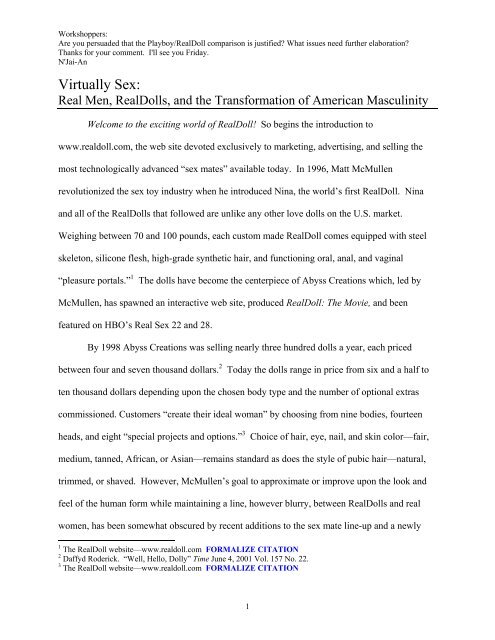Virtually Sex:
Virtually Sex:
Virtually Sex:
Create successful ePaper yourself
Turn your PDF publications into a flip-book with our unique Google optimized e-Paper software.
Workshoppers:<br />
Are you persuaded that the Playboy/RealDoll comparison is justified? What issues need further elaboration?<br />
Thanks for your comment. I'll see you Friday.<br />
N'Jai-An<br />
<strong>Virtually</strong> <strong>Sex</strong>:<br />
Real Men, RealDolls, and the Transformation of American Masculinity<br />
Welcome to the exciting world of RealDoll! So begins the introduction to<br />
www.realdoll.com, the web site devoted exclusively to marketing, advertising, and selling the<br />
most technologically advanced “sex mates” available today. In 1996, Matt McMullen<br />
revolutionized the sex toy industry when he introduced Nina, the world’s first RealDoll. Nina<br />
and all of the RealDolls that followed are unlike any other love dolls on the U.S. market.<br />
Weighing between 70 and 100 pounds, each custom made RealDoll comes equipped with steel<br />
skeleton, silicone flesh, high-grade synthetic hair, and functioning oral, anal, and vaginal<br />
“pleasure portals.” 1<br />
The dolls have become the centerpiece of Abyss Creations which, led by<br />
McMullen, has spawned an interactive web site, produced RealDoll: The Movie, and been<br />
featured on HBO’s Real <strong>Sex</strong> 22 and 28.<br />
By 1998 Abyss Creations was selling nearly three hundred dolls a year, each priced<br />
between four and seven thousand dollars. 2<br />
Today the dolls range in price from six and a half to<br />
ten thousand dollars depending upon the chosen body type and the number of optional extras<br />
commissioned. Customers “create their ideal woman” by choosing from nine bodies, fourteen<br />
heads, and eight “special projects and options.” 3<br />
Choice of hair, eye, nail, and skin color—fair,<br />
medium, tanned, African, or Asian—remains standard as does the style of pubic hair—natural,<br />
trimmed, or shaved. However, McMullen’s goal to approximate or improve upon the look and<br />
feel of the human form while maintaining a line, however blurry, between RealDolls and real<br />
women, has been somewhat obscured by recent additions to the sex mate line-up and a newly<br />
1 The RealDoll website—www.realdoll.com FORMALIZE CITATION<br />
2 Daffyd Roderick. “Well, Hello, Dolly” Time June 4, 2001 Vol. 157 No. 22.<br />
3 The RealDoll website—www.realdoll.com FORMALIZE CITATION<br />
1
Patters 2<br />
adopted marketing strategy. Despite or maybe because of these complications, McMullen claims<br />
that when they speak, the dolls will never say, “I love you.” 4<br />
Nevertheless, the distinction<br />
between the real world and the world of virtual fantasy is often a tenuous one, and Abyss keeps<br />
one foot on either side of an increasingly hazy line.<br />
The production, marketing and sale of these dolls speaks not only to the potentially<br />
reductive effects of technology, but also to the intricacies of American masculinity and male<br />
sexuality. Scholars of human sexuality have been conspicuously silent about male autoeroticism<br />
when it is aided by the use of sex toys. Academic feminists repeatedly point to the ways the<br />
vibrator transformed both popular and scholarly discourses about female sexuality, however, the<br />
marketing and consumption of similar products for men receives comparatively little analytical<br />
attention. While a central question of Maines’s groundbreaking history of the vibrator is, who<br />
controls women’s sexuality?, one question guiding a study of men’s use of sex toys might be,<br />
what does male sexuality express or control? 5<br />
Responding to this question through an<br />
examination of RealDolls reveals changes in popular understanding of the sex act, gender<br />
relations, sexualized consumption, marriage and fidelity.<br />
Despite the silence of scholars, critics of the dolls were swift to raise objections. College<br />
newspapers, pop-cultural feminist ‘zines, and mainstream news media were all quick to speculate<br />
about the cultural implications of the RealDoll even as they variously condemned Abyss<br />
Creations, its customers and what they perceived as U.S. society’s dehumanizing reliance on<br />
technology. 6<br />
Nevertheless, the sale of the dolls created more anxiety than disgust as<br />
4 Roderick, “Well, Hello, Dolly”.<br />
5 Rachel P. Maines, The Technology of Orgasm: “Hysteria,” the Vibrator, and Women’s <strong>Sex</strong>ual Satisfaction<br />
(Baltimore, 1999).<br />
6 For early public responses to the RealDoll, see: Leslie Harpold, “I’ve Been Replaced: Smug September, 1997;<br />
“Hello, Dolly” Arizona Daily Wildcat, Feb 19, 1998; Lisa Jervis and Andi Zeisler, “Plastic Fantastic Lover: Would<br />
You Have <strong>Sex</strong> with a Doll?” Bitch: Feminist Response to Pop Culture October 31, 1999 V.2; N.3; and Daffyd<br />
Roderick, “Well, Hello, Dolly” Time June 4, 2001 Vol. 157 No. 22
Patters 3<br />
commentators attempted to resolve the confusion generated by a model of masculinity that<br />
seemed at once undeniably primitive and impossibly futuristic. My investigation of the dolls<br />
connects their consumption not to simplistic models of male domination and hypersexuality, but<br />
to gendered systems deeply rooted in capitalism.<br />
One critic of the dolls wrote, “This is about fantasy in a way that’s both very basic and<br />
very high-tech.” 7<br />
This union of simplicity and complexity that both magnifies and exploits<br />
fissures in American society is one that has accompanied many popularly marketed outlets of<br />
male sexuality since the end of the Second World War. After examining the historical roots of<br />
this phenomenon beginning with the introduction of Playboy magazine and the onset of the<br />
sexual revolution, this essay will use the RealDoll to expose further the paradoxes within a<br />
framework of American male sexuality. It will focus on the ways the RealDoll highlights<br />
transformations in contemporary notions of marriage, fidelity, and economic self-sufficiency and<br />
demonstrate the mutually constitutive relationship these cultural changes have with U.S. political<br />
and economic development.<br />
The Culture of Playboy (Real Men)<br />
America has come alive again. And with the social revolution has come a sexual revolution as well. Gone is much<br />
of the puritan prudishness and hypocrisy of the past. But far from being representatives of a moral decline, as some<br />
would like us to believe, we are in the process of acquiring a new moral maturity and honesty in which man’s body,<br />
mind and soul are in harmony rather than in conflict. 8<br />
The sexual revolution is often employed as a vague, analytical catch-all that is signaled<br />
by any shift away from Victorian aversions to the exploration of sexuality. Indeed, Hugh<br />
7 Lisa Jervis and Andi Zeisler, “Plastic Fantastic Lover: Would You Have <strong>Sex</strong> With a Doll?” Bitch: Feminist<br />
Response to Pop Culture October 31, 1999 V.2; N.3 p.4.<br />
8 Hugh Heffner, The Playboy Philosophy, HMH Publishing Co., 1965, Vol. 1, Part 3, p. 17.<br />
The Playboy Philosophy began appearing in Playboy on the ninth anniversary of the first issue (December 1962).<br />
Written as a response to popular distortions of the magazine’s “aims and outlooks,” the 22 part description of<br />
“guiding principles and editorial credo” appeared in installments until May 1965. All parts of the Philosophy were<br />
eventually compiled into a four volumes by HMH Publishing Co., Inc. It is from this sometimes expanded edition<br />
that I quote.
Patters 4<br />
Heffner characterizes it as an almost spiritual enlightenment that rescues those in its path from<br />
the repression of “puritan prudishness.” Paired with the social revolution the presumed object of<br />
which is justice and equality, Heffner’s sexual revolution seeks to achieve no less than physical,<br />
moral, and spiritual liberation at the individual and cultural levels. The libratory ideology he<br />
espouses through Playboy and its Philosophy advocates a redistribution of power, privilege and<br />
space—a call for men to reclaim those things that progress has stolen from them by redefining<br />
the modern rather than exalting the traditional. Using varied rhetorical techniques, Playboy<br />
develops a culture that repeatedly exploits the anxieties of the larger American society even<br />
when such cultural opportunism points to internal inconsistencies. The editors’ strategic and<br />
rhetorical savvy is revealed in the way Playboy markets itself in relation to Cold War<br />
imperatives of scientific advancement, virile masculinity, consumption, capitalism, marriage and<br />
the domestic sphere. Thus, the culture of Playboy and the broader American culture into which<br />
it enters exist in continual conversation, each adjusting itself to exploit the possibilities revealed<br />
by the other.<br />
Heffner’s call to “moral maturity and honesty” nearly a decade after the publication of<br />
the first issues of Playboy, for example, marked a rhetorical shift away from an unswervingly<br />
secular reliance on science. Initially published in December 1953, Playboy claimed Alfred<br />
Kinsey as its intellectual father. The magazine used his work to establish and cement its hold on<br />
legitimacy. Indeed, The Playboy Philosophy makes no fewer than 35 references to Alfred<br />
Kinsey. Amidst the domestic repression and reorganization spawned by the first decade of the<br />
Cold War, Playboy used Kinsey to lay claim to reason as it located its male clientele within the<br />
peculiar space between tradition and modernity. The magazine’s initial claims to legitimacy and<br />
quasi-modernity were grounded not in its willingness to discuss and display the human form, but
Patters 5<br />
rather in the editors’ knowledge of scientific currency. In the early years of publication, efforts<br />
to preemptively silence criticism of the sexually explicit content of the magazine did not lay<br />
claim to a moral high road, but instead to scientific and sometimes an educational necessity.<br />
The cultural stage onto which Playboy entered was one that had spotlighted human<br />
sexuality since Kinsey’s 1948 publication of <strong>Sex</strong>ual Behavior in the Human Male. Though<br />
Kinsey was not the first scholar to undertake a scientific investigation of human sexuality, his<br />
body of research was (and remains) the most extensive of its kind. It reached an unprecedented<br />
audience and enjoyed a more favorable reception than its antecedents. “George Gallup reported<br />
that one out of every five Americans had either read or heard about the book, while five out of<br />
six of those interviewed judged its publication ‘a good thing.’” 9<br />
The scope and breadth of the<br />
research were not the only factors contributing to the popular reception of Kinsey’s <strong>Sex</strong>ual<br />
Behavior in the Human Male or its 1953 sequel, <strong>Sex</strong>ual Behavior in the Human Female.<br />
According to Regina Morantz, “What made Kinsey different—indeed, what made him unique—<br />
was his confidence that Americans were ready for a confrontation with their own sexuality. In<br />
dispassionate prose he laid bare the facts.” 10<br />
With considerably more passion and laying bare of<br />
subjects, the editors of Playboy took up what they perceived as Kinsey’s legacy and exploited the<br />
cultural space that his research created.<br />
On the opening page of Playboy’s inaugural issue, the editors proclaimed, “We<br />
believe…that we are filling a publishing need only slightly less important than the one just taken<br />
care of by the Kinsey Report,” making explicit their connection to Kinsey, his educational and<br />
libratory aims, and the cultural validity his research achieved. 11<br />
Like Kinsey, Playboy treats sex<br />
9 Regina Markell Morantz, “The Scientist as <strong>Sex</strong> Crusader” Alfred C. Kinsey and American Culture,” American<br />
Quarterly Vol. 29 No. 5 Winter 1977, p. 564.<br />
10 Morantz, 564.<br />
11 Hugh Heffner, “What is Playboy?,” Playboy, December 1953, p. 2
Patters 6<br />
and challenges social control, but the manner in which these goals are understood (never mind,<br />
accomplished) is markedly different. Take for example Kinsey’s stated purpose to:<br />
bring an educated intelligence into the consideration of such matters as sexual adjustments in marriage, the<br />
sexual guidance of children, the premarital sexual activities which are in conflict with the mores, and<br />
problems confronting persons who are interested in the social control of behavior through religion, custom,<br />
and the forces of law. 12<br />
Seemingly altruistic and avowedly intellectual, Kinsey’s research provides data “divorced from<br />
questions of moral value” 13<br />
His frank, dispassionate attitude towards sexual matters has little in<br />
common with the ribald treatment given to the same subject by the editors of Playboy. Indeed,<br />
when expressing their attitudes toward sex, the editors announced:<br />
[W]e must confess at the outset that we do not consider sex either sacred or profane. And as a normal, and<br />
not uninteresting, aspect of the urban scene, we think it perfectly permissible to treat the subject either<br />
seriously or with satire and good humor, as suits the particular situation. 14<br />
While Playboy cannot be linked with the moralizers Kinsey sought to overcome, its editorial<br />
credo was no less exclusive or dogmatic. That is, those unable to separate sex from the sacred or<br />
profane had no place in a Playboy culture or in the broader society that culture was attempting to<br />
create. 15 Unlike Kinsey, Playboy’s intended audience was exclusively male, and its educational<br />
aims were dubious at best. Targeting men between the ages of eighteen and eighty, Playboy<br />
sought to reclaim men’s homes and appetites by providing them with “a pleasure-primer styled<br />
to the masculine taste.” 16<br />
The editors created a masculine space, a land for grown-up Peter Pans<br />
who wanted to enjoy adult pleasures away from the stresses of adult pressures. The masculine<br />
community provided by Playboy and enjoyed by adherents to its Philosophy arguably provided<br />
12 Quoted in Morantz, 568.<br />
13 Alfred C. Kinsey, <strong>Sex</strong>ual Behavior in the Human Male, (Philadelphia, 1948), 3.<br />
14 Hugh Heffner, The Playboy Philosophy, HMH Publishing Co., 1965, Vol. 1, Part 1, p. 4.<br />
15 “What is Playboy?,” the introduction to the first issue of the magazine reads, “We want to make it clear from the<br />
very start, we aren’t a ‘family magazine.’ If you’re somebody’s sister, wife or mother-in-law and picked us up by<br />
mistake, please pass us along to the man in your life and get back to your Ladies Home Companion.” December<br />
1953, p.2.<br />
16 “What is Playboy?,” Playboy, December 1953, p. 2.
Patters 7<br />
some grounds for the public to turn a blind eye to the sexually explicit content of the magazine or<br />
at least to limit their objections to verbal condemnation rather than legal sanction. Just as its<br />
association with Kinsey—and therefore, science—was directed at American insecurities about<br />
intellectual inferiority, the masculine community fostered by Playboy was aimed at increasing<br />
fears about the “softening” of American men.<br />
In the aftermath of World War II, U.S. gender constructs were destabilized by a myriad<br />
of developments including public attention to increased female participation in the work force,<br />
increased regulation of visible homosexual communities, and the growing success of campaigns<br />
for social integration. The early years of the Cold War acted as a transitional period that linked<br />
the female dependence on a male breadwinner model with the model of male and female<br />
individuality and self-sufficiency celebrated by Playboy as a cornerstone of modern capitalism.<br />
This new economic individuality was advanced by a limited wave of economic affluence which<br />
placed renewed emphasis on commercial culture.<br />
The celebrated and feared consumer explosion of the 1920s returned full force in the<br />
post-War years, its critics obscured by the shadow of the Great Depression and silenced by the<br />
roar of Cold War government propaganda. Consumer goods provided an avenue for people to<br />
express their individuality at the same time that they demonstrated adherence to community<br />
standards of beauty, leisure, and status. In this way, consumerism united individuality with<br />
familial dependence and cultural conformity.<br />
This increased focus on consumerism led to fears that American men were becoming too<br />
“soft.” 17<br />
In response, Cold War gender ideals celebrated male dominance and vigor by<br />
promoting participation in activities and membership in communities designed to enhance<br />
normative masculine tendencies. The publication of Playboy bears a contextual link to other<br />
17 Elaine Tyler May, Homeward Bound: American Families in the Cold War Era (New York), 1998.
Patters 8<br />
developments of the period such as the birth of NASA, increased membership in the Boy Scouts,<br />
and the establishment of several other groups devoted to encouraging boys and men to explore<br />
and/or conquer the world around them in defense of American values (most notably among them<br />
the Peace Corps in 1961). At the same time, popular culture continued to place increasing<br />
emphasis on leisure and sensual gratification. Technology merged with this plurality to create<br />
space for the celebration of a new type of man: the playboy.<br />
[The playboy] can be a sharp-minded young business executive, a worker in the arts, a university professor,<br />
an architect or an engineer. He can be many things, providing he possesses a certain point of view. He<br />
must see life not as a vale of tears, but as a happy time; he must take joy in his work, without regarding it as<br />
the end and all of living; he must be an alert man, an aware man, a man of taste, a man sensitive to<br />
pleasure, a man who—without acquiring the stigma of the voluptuary or dilettante—can live life to the hilt.<br />
This is the sort of man we mean when we use the word playboy. 18<br />
Playboy, beginning in the early 1950s, and the eventual proliferation of films like American<br />
Gigolo, Shampoo, and Saturday Night Fever by the mid 1970s “advocated a life of pleasurable<br />
consumption,” 19 and showcased this new American man as a product of capitalist democracy.<br />
The playboy as he was described and understood by his editorial creators existed among a<br />
community of like-minded brethren. In fact, the continued popularity of Playboy magazine<br />
hinged on the community it created for its playboy consumers. Heffner himself recognized the<br />
centrality of community to the Playboy phenomenon even as he acknowledged that consumption<br />
was the central mechanism through which such a community was sustained. In reference to his<br />
customers, Heffner wrote, “They sought, and we gladly supplied, a mark of identity in common<br />
with the publication—the sort of honor a man usually reserves for his fraternity, or a special<br />
business or social association.” 20<br />
This attention to creating a fraternal culture for playboys led<br />
historian Barbara Ehrenreich to assert that female nudity was peripheral to the true aims of the<br />
magazine—creating an escape from marriage and (re)claiming the domestic sphere for men.<br />
18 BLANK, “What is a Playboy?” Playboy April 1956, ?.<br />
19 Barbara Ehrenreich, The Hearts of Men (New York, 1983), 44.<br />
20 Heffner, The Playboy Philosophy, Vol. 1, pg. 1.
Patters 9<br />
Indeed, the display of women’s bodies functioned not only as a primer for masculine pleasures as<br />
the editors claimed, but also as an assurance to playboys (and their critics) that there was nothing<br />
“soft” or “queer” about participating in this masculine community. 21<br />
Preempting charges of homosexuality was only prudent since members of Playboy<br />
culture performed their masculinity through participation in an all-male group that was defined<br />
by consumption—a traditionally feminized pursuit.<br />
We first became aware that Playboy was developing into something more than a magazine when readers<br />
began purchasing Playboy Products in considerable quantities: everything from cuff links, ties, sport shirts,<br />
tuxedoes and bar accessories to playing cards, personalized matches and stickers for their car windows—all<br />
with the Playboy Rabbit as the principal design and principal motivation for purchase. 22<br />
Additionally, the playboy rejected marriage while embracing intellectualism and the domestic<br />
sphere.<br />
Most of today’s ‘magazines for men’ spend all their time out-of-doors—thrashing through thorny thickets<br />
or splashing about in fast flowing streams. We’ll be out there too, occasionally, but we don’t mind telling<br />
you in advance—we plan on spending most of our time inside.<br />
We like our apartment. We enjoy mixing up cocktails and an hors d’oeuvre or two, putting a little mood<br />
music on the phonograph, and inviting in a female acquaintance for a quiet discussion on Picasso,<br />
Nietzsche, jazz, sex. 23<br />
Playboy needed naked women to dispel assumptions of homosexuality in a period when<br />
accusations of perversion ran rampant. “The playboy didn’t avoid marriage because he was a<br />
little bit ‘queer,’ but, on the contrary, because he was so ebulliently, even compulsively<br />
heterosexual.” 24<br />
Defining the bachelor as a viable model of adult masculinity flew in the face of<br />
the Cold War emphasis on the nuclear family, while placing him at the center of an exclusively<br />
male community that “liked [their] apartments” and enjoyed entertaining threatened rigidly<br />
21 Barbara Eherenreich, The Hearts of Men: American Dreams and the Flight from Commitment (New York, 1983),<br />
50-51.<br />
22 Heffner, Playboy Philosophy, Vol. 1, Part 1, p. 1.<br />
23 Playboy December 1953, Vol.1 No.1, p.1.<br />
24 Eherenreich, 50.
Patters 10<br />
enforced codes of acceptable (hetero)sexuality. However, Playboy’s transgressive properties<br />
stopped there; the magazine is more aptly described as rebellious than revolutionary. 25<br />
Even as it critiqued matrimony and placed the bachelor within the home, Playboy<br />
embraced capitalist imperatives, reviled communism, and encouraged adherents to its Philosophy<br />
to work for the expansion of the American way of life.<br />
To some of us capitalism is almost a dirty word. It shouldn’t be. It’s time Americans stopped being<br />
embarrassed and almost ashamed of their form of government and their economy. It’s the best two-horse<br />
parlay in the world and perhaps if we were more fully sold on it ourselves, we could do a better job of<br />
selling it to other countries…For today, in America, a new generation is taking over—with all the upbeat<br />
spirit, questing impatience and rebel derring-do that are needed to put the United States back in the position<br />
of world leadership. 26<br />
Once again Heffner engages with broader political and cultural conditions, simultaneously<br />
playing on American fears about losing the Cold War (“put the U.S. back in the position of<br />
world leadership”) while celebrating the very foundation of America’s ideological platform and<br />
positioning himself (and his magazine) as the true, unashamed champion of capitalism.<br />
Playboy engaged with the American way of life articulated by the government through<br />
policy and propaganda which united capitalism, consumerism, democratic institutions, individual<br />
freedom, and the nuclear family in a way that placed Americans in direct opposition with the<br />
drudgery and conformity embodied by the Soviets under communism. 27<br />
Indeed, the only<br />
objection the magazine had to this socio-political agenda was over the issue of marriage, and<br />
even that was often framed in terms of anti-Communist individualism.<br />
[W]e have always stressed—in our own way—our conviction of the importance of the individual in an<br />
increasingly standardized society, the privilege of all to think differently from one another and to promote<br />
new ideas, and the right to hoot irreverently at herders of sacred cows and keepers of stultifying tradition<br />
and taboo. 28<br />
25 Eherenreich, 50.<br />
26 Heffner, Playboy Philosophy, Vol. 1, Part 2, p. 14.<br />
27 For more on the ideologies of “American way of life” during the Cold War, see Elaine Tyler May, Homeward<br />
Bound (New York, 1998).<br />
28 Heffner, Playboy Philosophy, 3.
Patters 11<br />
According to Heffner, the playboy—not the married, family man—was the real man of the post-<br />
War era, the man whose intellectual individuality made him an invaluable soldier in the Cold<br />
War.<br />
The playboy as real man, as uncommon and exceptional specimen is a central theme of<br />
the magazine and its editorial Philosophy.<br />
The upbeat generation has arrived and its conflict with the old ways, the old idea, the old traditions and<br />
taboos is evident all around us. After 20 years of Depression-bred and War-nurtured conformity, and<br />
compulsive concern with security and the common man, the Uncommon Man has at last come back into his<br />
own, along with a renewed respect for the uncommon mind, the uncommon act and the uncommon<br />
accomplishment. 29<br />
By itself, this, perhaps, would be unremarkable, a mere marketing strategy. However, the editors<br />
of Playboy repeatedly demonstrated their ability to position their magazine and its subjects in<br />
relation to broader socio-political developments. This strategic know-how is evidenced not only<br />
by early celebration of Kinsey and his work, but also in the union of Playboy masculinity with<br />
capitalist democracy, the magazine’s celebration of the individual, and the elevation of the<br />
playboy to intellectual and cultural pioneer. This Playboy approach to constructing and<br />
marketing masculinity and male sexuality through attention to sex, marriage and the domestic<br />
sphere, and individuality becomes the foundation for subsequent post-War attempts to appeal to<br />
masculine appetites.<br />
By the 1990s, the playboy changed to reflect a younger, hipper, unabashedly<br />
***<br />
consumption oriented, technologically savvy generation. Hugh Heffner re-married in 1988 not<br />
only forsaking his own “freedom,” but also undermining the playboy credo he began authoring<br />
in 1962. Though Playboy remained enormously popular, in many ways it became passé. Men’s<br />
pornography was augmented by the emergence of virtual culture: realistic vaginas and interactive<br />
29 Heffner, Playboy Philosophy, 15.
Patters 12<br />
computer simulations paved the way for McMullen’s RealDoll. While its playboy consumer<br />
added technology to a list of defining characteristics that already included consumption and<br />
sexual gratification.<br />
Even as the playboy continued to develop and spread his wings, the broader culture that<br />
once fostered him was in the midst of a hard turn to the right. The resulting cultural anxiety<br />
about masculinity in crisis was evidenced in everything from attention to incarceration rates for<br />
black men to panic surrounding the feminization of the professional [read white] man. 30<br />
Instead<br />
of creating space for the playboy’s once rebellious masculinity or solidifying his hold on<br />
fantasies of American virility, these developments pushed him off of the solid ground he enjoyed<br />
from the 1950s through the mid-1970s. Despite the proliferation of increasingly advanced sexual<br />
outlets for men, the pride with which they were consumed was tinged with a kind of selfconscious<br />
defensiveness that was not present in the earlier period. The anxieties surrounding the<br />
union of consumption and male sexuality once again center issues of marriage, individuality, and<br />
economic self-sufficiency. Like Playboy, Abyss Creation’s RealDoll was positioned as man’s<br />
escape from cultural conformity even as it was imagined as pioneering a new cultural order.<br />
RealDolls<br />
Realistic, life-size and beautiful. Elastic flesh, an articulated skeleton and sexy features like no other love doll in the<br />
world. If you've dreamed of a love doll like this, you know exactly what we're talking about. Most love dolls are<br />
made of cheap, inflatable vinyl. They look pathetic and laughable—not loveable. Don't expect to see those goofy<br />
beach toys on this site. RealDoll is the REAL DEAL. 31<br />
RealDolls are marketed almost exclusively on-line, and the official RealDoll website is<br />
the principal source of information about the dolls, their creator, and their reception. 32<br />
Before its<br />
January 2002 facelift, the site’s presentation simultaneously personified and dehumanized the<br />
30 Susan Faludi, Stiffed: The Betrayal of the American Man, (New York, 1999).<br />
31 www.realdoll.com , April 2001. FORMALIZE CITATION<br />
32 Over the course of 2004, Abyss creations has partnered with Hustler and Heidi Fleiss to display and sell the<br />
RealDoll in two California locations.
Patters 13<br />
dolls. The changes in the site point towards transformations in masculine imperatives and<br />
cultural approaches to sex, and to a lesser extent, marriage. What follows is a summary of the<br />
material presented on the website (before and after the renovation), an analysis of the manner in<br />
which it is presented and the implications of its presentation.<br />
The first thing encountered after logging on to the pre-renovation RealDoll website was a<br />
warning that the site contained sexual and erotic material that should not be shown to minors.<br />
After certifying that one had reached the age of majority, access to the site was permitted.<br />
Entrance into the body of the website was preceded by a short flash film that welcomed the<br />
viewer into a fraternity of RealDoll enthusiasts by using quotes from doll consumers—“Best sex<br />
I ever had…I did it and I’m proud of it…The only thing better would be two…I can’t take my<br />
hands off her.” The last quote was played overtop of an image of male hands fondling RealDoll<br />
breasts—no other part of the doll’s body was visible. The remainder of the film contained a<br />
montage of disconnected body parts interspersed with text—“I could fall in love…lips so<br />
real…face so real…body so REAL.” The doll’s face was only shown clearly once, and was<br />
never clearly shown connected to its body. The presentation concluded with the following<br />
question, “constructing the perfect woman—silicone and steel, or flesh and blood?”<br />
Though all flash presentations were removed from the site, this question continues to<br />
underlie the fabrication, marketing, and consumption of all RealDolls. Abyss Creations<br />
promises consumers the perfect woman, but for the fact that it is a doll. Therein lies the<br />
contradiction. Abyss makes it clear that the RealDoll is the perfect woman precisely because it<br />
is a doll. The very things about it that mark it as artificial (measurements, passivity, near<br />
indestructibility) are the things that are celebrated. The perfect woman, then, is a combination of
Patters 14<br />
a “real,” though somewhat stylized physical form with the lifeless compliance of an inanimate<br />
doll.<br />
As such, the dolls play a critical role in a gender structure that celebrates manly vigor.<br />
As in most essentialist frameworks, the doll is placed in diametric opposition with its male<br />
counterpart. It is weak where the man is strong; it is passive where the man is aggressive; the<br />
man is penetrator, and the doll, penetrated. The physical body assumes a central position in<br />
making distinctions between sexed beings, particularly when the act of sex is vital to the<br />
construction of that gender. This, perhaps, is why the RealDoll website devotes so much space<br />
to detailing the dolls’ physical attributes. (See table below.)<br />
specs body 1 body 2 body 3 body 4 body 5 body 6/7 body 8 body 9<br />
flesh material:<br />
skeleton:<br />
hair:<br />
height:<br />
weight:<br />
high grade silicone rubber<br />
PVC w/ steel joints, urethane foam and vinyl components<br />
synthetic<br />
5'7"<br />
(approx.)<br />
80 lbs<br />
(approx.)<br />
5'1"<br />
(approx.)<br />
70 lbs<br />
(approx.)<br />
5'10"<br />
(approx.)<br />
100 lbs<br />
(approx.)<br />
5'1"<br />
(approx.)<br />
75 lbs<br />
(approx.)<br />
5'1"<br />
(approx.)<br />
75 lbs<br />
(approx.)<br />
5'4"<br />
(approx.)<br />
80/85 lbs<br />
(approx.)<br />
5'5"<br />
(approx.)<br />
100 lbs<br />
(approx.)<br />
5'4"<br />
(approx.)<br />
90 lbs<br />
(approx.)<br />
bust: 34C 34D 38DD 34A 34E 34B/C 36C 44FF<br />
waist: 23" 22" 26" 24" 24" 24" 26" 24"<br />
hips: 34" 34" 36" 34" 34" 36" 38" 35"<br />
dress size: 5 3 5-7 1-3 3-5 3-5<br />
shoe size: 5 5 7 5 5 7<br />
hair color:<br />
hair style:<br />
skin tone:<br />
eye color:<br />
eye shadow:<br />
eyeliner:<br />
eyeliner color:<br />
light blonde, medium blonde, auburn, red, brunette, brown, black<br />
select from 10 styles<br />
fair, medium, tanned, Asian, African<br />
blue, brown, green, light green, light blue, hazel<br />
natural, slate, rose, plum, bronze, khaki<br />
heavy, medium, or light<br />
black, grey, brown, or blue
Patters 15<br />
lipstick color:<br />
nail color:<br />
pubic hair<br />
color:<br />
apricot, pink, red, plum, bronze or natural<br />
french manicure, pink, red, burgundy, or bronze<br />
blonde, red, or brunette<br />
pubic hair style: shaved, trimmed, natural<br />
vaginal entry:<br />
anal entry:<br />
oral entry:<br />
standard w/ doll<br />
standard w/ doll<br />
standard w/ doll<br />
Detailed specifications of the dolls are presented for each of the nine RealDoll body<br />
types. The “silicone and steel or flesh and blood” question remains present in the description of<br />
the bodies. Barbie-like proportions are enhanced by lifelike skin, hair, and functionality. The<br />
perfect female body is one that surpasses the limitations of a living human form while<br />
maintaining a sensual and aesthetic hold on being lifelike. The site also displays the fourteen<br />
head options—Leah, Stacy, Celine, Tami, Amanda, Stephanie, Melissa, Angela, Jenny, and<br />
Brittney, along with the “fantasy” Anna Mae and the three non-white dolls, Mai, Nika, and<br />
Kaori—and devotes a photo gallery to each doll. Each doll’s album has shots of them dressed up<br />
and dressed down; all are posed, at least once, fondling themselves, and most are featured<br />
kneeling with their faces obscured and their exposed genitals in the foreground. There is a great<br />
effort, in these albums, to give the dolls distinct personalities—the clothing choice, lighting, and<br />
setting is varied from one doll to the next. This focus places an emphasis on the display of the<br />
entire doll as a unified entity. It turns away from the objectification of the early flash films that<br />
did not have clear images of a complete doll, only pictures of its parts.<br />
The dolls are marketed as man’s ultimate technological achievement—the creation of<br />
“the perfect woman.” <strong>Sex</strong> with dolls is better; the dolls are always “ready and available,” and<br />
their bodies are second to none. They are constructed (literally and in their marketing campaign)
Patters 16<br />
to provide all the benefits of a female partner without any of the hassles involved with<br />
interpersonal interaction. Curiously, Abyss Creations’ message is most contradictory when it<br />
relates the RealDoll to women and other sex toys, as if it too is cannot decide where the dolls fit.<br />
It is clear that Abyss wants to make a distinction between its product and others that are<br />
available. The RealDoll is “no inflatable pool toy;” 33 it is a life-like model designed to take its<br />
users “to the next level of auto eroticism” 34 within a context where the consumer has absolute<br />
control over determining the terms of the interaction. As Leslie Harpold writes, the sexual<br />
stimulation provided by the doll “is tertiary in importance, according to the information<br />
presented, to the fact that this is a sexual partner who will not make demands and requires none<br />
of that pesky foreplay or conversation.” 35<br />
The dolls are so life-like, however, that photographs of them may fail to adequately<br />
communicate their inanimate status (the thing that sets them apart from and above women). That<br />
is, some of the images appear so real, that it is difficult to distinguish between a doll and a living<br />
woman. Moreover, Abyss intentionally furthers this confusion. The dolls are sometimes shown<br />
in pieces, with obscured or expressionless faces, made pliable by their dehumanization. At other<br />
times, however, explicit attempts to give the dolls personality are made beginning with the<br />
naming of each doll. Images of dolls wearing jewelry and clothes, and staged photographs of<br />
dolls “sunbathing” or “entertaining” endeavor to animate the dolls, or, at the very least, deemphasize<br />
their lifelessness. This may be read as further evidence of an attempt to<br />
simultaneously place the dolls in multiple spheres of existence. The only way to resolve the<br />
contradiction is to purchase a doll.<br />
*Image from Leslie Harpold, “I’ve Been Replaced” Smug September, 1997.<br />
33 The RealDoll website—www.realdoll.com<br />
34 Harpold, 2.<br />
35 Harpold, 2.
Patters 17<br />
Further humanizing its image, the website removed all images of the dolls tied up,<br />
stretched out, wearing leather, holding whips (except for the fantasy doll, Anna Mae), or<br />
positioned in other S/M poses after the 2002 face-lift. Still, Abyss continues to publish its<br />
warning that though sturdy, the dolls are “not meant to sustain extremely violent abuse.” A<br />
problematic issue to be considered is the extent to which one can discuss violence as a possibility<br />
with a doll. The warning issued by Abyss is written in language that comes more close to fully<br />
humanizing the dolls than most of the rest of the site. This begs two questions: can violence be<br />
understood in the same terms when applied to a specimen that “can withstand over 300%<br />
elongation” of its “flesh”?, and what is revealed by the fact the most clearly articulated link<br />
between RealDolls and real women is their subjection to violent treatment?<br />
Features<br />
*Elastic—flesh can withstand over 300% elongation<br />
*Heat Resistant—can withstand over 300 degrees of heat<br />
*Water Resistant—solid construction<br />
*Stain Resistant—nothing sticks to silicone flesh<br />
*Durable—long life silicone rubber<br />
*Lifelike—anatomically correct, parts molded from life-casts<br />
*Odorless and Flavorless<br />
*Flexible—wide range of joint movement<br />
*<strong>Sex</strong>y and Pleasurable—provides effective aid to sexual fulfillment<br />
*Safe—no risk of disease, non-toxic<br />
*Convenient—always ready and available<br />
*Relaxing and Comforting—provides stress-free companionship<br />
*Affordable—cheaper than most alternatives<br />
Constructing the perfect woman as a lifeless doll, capable only of sex, is problematic.<br />
Add a “willingness” to engage in any activity, or be subjected to any treatment, and the dolls<br />
further complicate one’s understanding of where and how men and women are placed within this<br />
gendered society. The website’s attention to depicting and addressing violent treatment of the<br />
dolls is framed by a presentation of the dolls as “perfect women.” That is, the doll can and will<br />
withstand nearly any treatment without being injured or killed. Indeed, there is no appreciable
Patters 18<br />
change in the doll because it already has “the poise and relaxed state of a sleeping [or dead]<br />
girl.” 36 The existence of a male RealDoll problematizes this analysis. It cannot be relegated to an<br />
exclusively feminine role of passivity and reception because it has the ability to be the penetrator<br />
within the sexual act as well. (Though, technically, since it lacks anamatronic capabilities, one<br />
might think of the male doll as being enveloped rather than as penetrator.). One can conceive of<br />
it being purchased and used by a woman, though the doll’s lack of anamatronic function suggests<br />
that it is intended for male consumption. In fact, a “45 year old mother of one” wrote to the<br />
company, “I’m looking forward to a male version. I don’t think women will buy many, but men<br />
sure will.” 37<br />
Abyss Creations is confounded by its own creation. Apart from a proclamation that<br />
“”the male RealDoll has arrived” and an album of photographs, the doll is left untreated. Indeed,<br />
the website continues to refer to the vaginal entry as “standard.” The male doll has no place in<br />
the RealDoll world. Abyss cannot celebrate the pliable passivity of a male doll at the same time<br />
that it tries to court the masculine virility of its male consumers.<br />
However, RealDoll is more than a technological and marketing phenomenon. The dolls<br />
reveal a masculinity that is dominated by desire, passion, lust, and, to some extent, emotion.<br />
Historically, these traits have been negatively valued and ascribed to women. To the extent that<br />
they were recognized in men, they were tempered by the use of man’s superior reason and<br />
rationality. Men were not supposed to prominently display their passions, and they certainly<br />
were not to incite them in other men for economic gain. Heffner’s playboy took the first steps<br />
away from these early, stoic models of masculinity and Abyss Creation’s RealDoll customers<br />
completed the journey.<br />
36 The RealDoll website<br />
37 www.realdoll.com/letters.asp September 2004.
Patters 19<br />
The Transformation of American Masculinity<br />
Since the 1990s, the development, marketing, and consumption of men’s sex toys<br />
revealed changes in the construction of American masculinity and exposed the paradoxes<br />
embodied by the propagation of a rigid gender role that is both in opposition to and achieved by<br />
participation in consumer culture. After World War II, American manhood was defined by two<br />
competing masculine constructs: that of masculinity as innate domination over “others”—nature<br />
(land), institutions (property/capital), women (and children), etc.—and that of masculinity as a<br />
quest to maximize one’s status through the accumulation of material goods. The implicit<br />
contradiction is that men are owners by virtue of their maleness, but that to be a man one must<br />
acquire objects to establish a status of ownership—land (nature), property (institutions), children<br />
(and women), etc. Distinctly masculine ownership constructs, then, are both innate and<br />
achieved. Building on existing scholarship surrounding the “softening” of American men by<br />
consumerism, men’s use of sex toys, particularly life-size, life-like RealDolls can be understood<br />
as a way for them to assert sexual and physical dominance (the traits stolen by consumerism)<br />
within a pattern of commercial consumption (the very thing that makes them “soft”).<br />
The RealDoll, designed for male sexual gratification and available for purchase,<br />
simultaneously fits into both definitions of American manhood. One could understand the use of<br />
these dolls in one of two ways: as fundamentally repressive because it unites both masculine<br />
ownership constructs, or as liberating because it places primary emphasis on individuality by<br />
allowing men to articulate and experience their masculinity and sexuality alone. This tension<br />
illuminates a central paradox—masculinity not as a status but a never-ending quest for an elusive<br />
and contradictory reward. The process of accumulation that establishes and maintains<br />
masculinity is continuous, and masculinity is so inextricably linked to consumerism that one can
Patters 20<br />
never fully achieve it. Masculinity is constantly repackaged in the products that act as an outlet<br />
for its expression; there is always a newer, fresher, more advanced masculinity for sale. Playboy<br />
and Abyss Creations both rely on men’s needs to perform their masculinity through continued<br />
consumption.<br />
Playboy and Abyss Creations approaches to constructing masculinity exist on a<br />
continuum with Playboy at one end and the RealDoll resolving the inconsistencies and<br />
contradictions of the Playboy position. Both attend to issues of marriage, individuality and<br />
community. Moreover, both are invested in defining the limits of sex. That is, to satisfy the<br />
needs of their constituents, Abyss Creations and to a lesser extent, Playboy narrowly define the<br />
sex act so that the use of their product falls outside of the bounds of intercourse. These<br />
distinctions and continuities are revealed by the testimonials and letters received by both<br />
companies.<br />
The testimonial feedback featured on the RealDoll website waxes poetic about the dolls’<br />
realistic bodies. Each one was written about a female doll, and submissions that explicitly stated<br />
the sex of the consumer were written by men. Howard Stern, who was given a RealDoll soon<br />
after Abyss began selling them, said:<br />
Best sex I ever had! I swear to God! This RealDoll feels better than a real woman! She's fantastic! I love her!<br />
This RealDoll is for real, I swear! Better than a woman! My wife isn't as good as that! May God take away all<br />
my ratings if I'm lying! I'll take a lie detector test! I swear on the life of my children! I did it and it was<br />
fulfilling! I did it and I'm proud of it! It was great! It was the best sex I ever had! Thank you RealDoll.com! It<br />
was fabulous! I could fall in love with that thing! [Emphasis added.]<br />
Sterns testimonial is typical in that the primary focus is on him. The doll is merely a conduit for<br />
his sexual fulfillment and expression of virile masculinity.<br />
In Sterns’ testimonial and many of the others featured on the site, one cannot help but<br />
marvel at the rhapsodic tone that is employed.
Patters 21<br />
I just got my Real Doll this morning. I think I'm in love! THANK YOU! Man, you guys really<br />
deliver. If my doll is any example then your site does NOT do your dolls justice. Leah's face is<br />
SO beautiful and her breasts are AMAZING! How do you do that?! I can't keep my hands off<br />
her! I must admit that I was a bit worried about the size of the crate, but now I can see why it has<br />
to be that way and it really did a great job of protecting Leah during shipping ...you'll be happy to<br />
know she arrived in perfect shape! Leah and I had some wild fun this evening and I've got big<br />
plans for her this coming weekend. I cannot get over how REAL she looks and feels! You have<br />
made me one very happy man and I hope you guys go out there and make many more men<br />
happy! name withheld by request<br />
Still, it is in Sterns’ comments—his declaration of pride and repeated swearing—that a hint of<br />
anxiety bubbles to the surface. The reader must ask why it is necessary for Sterns to assert pride<br />
in consumption, to what assumed challenge is he responding? Though left unstated, the anxiety<br />
implicit in Sterns’ remarks and those of all RealDoll consumers is the very thing that the website<br />
is designed to alleviate. That is Abyss attempts to respond to the unasked question: Why can’t<br />
you get a real girl/woman? And the answer it provides is one that originated in the 1960s and<br />
70s, but rings a bit hollow today—real men can use RealDolls, in fact using RealDolls proves<br />
real manhood.<br />
Also posted on the website are letters sent to Abyss from the curious, the interested, and<br />
the awed. One of the most striking features of the letters is the parallel of their content with the<br />
first issue of Playboy. Barbara Ehrenreich writes of “Miss Gold-Digger 1953,” Playboy’s first<br />
full length feature article, “from the beginning, Playboy loved women—large-breasted, longlegged<br />
young women, anyway—and hated wives.” 38<br />
RealDoll enthusiasts hate divorce far more<br />
than they hate matrimony. However, implicit in the dread of economic ruin through a separation<br />
of property, is the idea that marriage restricts men from freely expressing their sexual selves, and<br />
but for the punitive nature of divorce, all men who made the mistake of marrying would choose<br />
to free themselves from it. Of the marital status of its readers, the first issue of Playboy reported,<br />
“approximately half of Playboy’s readers (48.6%) are free men and the other half are free in<br />
38 Ehrenreich, 42.
Patters 22<br />
spirit only.” 39<br />
Here one sees the articulation of a link through similar conceptions of marriage as<br />
sexually oppressive for men, and divorce (or what Playboy refers to as “the whole concept of<br />
alimony” 40 ) as economically ruinous for them.<br />
The RealDoll, like Playboy, assuages fears of divorce by presenting married men with an<br />
opportunity to have other sexual partners outside of the context of infidelity. Men responded<br />
enthusiastically. The following are two submissions:<br />
This is hands down THE most incredible piece of functional/functioning art I have ever seen! I'm<br />
almost speechless.... If I had any extra cash, I would buy 20 of them and leave them around my<br />
home in various positions of readiness. Why get divorced and give up half of your assets when<br />
you can invest five grand for one of your pleasure machines?!!!<br />
I gotta say, I'm impressed!! In all my life I have never seen anything so fascinating. I have often<br />
thought of infidelity and the consequences surrounding it, (losing half your assets is a bitch!) but<br />
these dolls could put divorce lawyers out of business! (Not that I would mind!) I'm breaking out<br />
the Platinum card baby!<br />
One repeatedly reads that marriage forces men to suppress their “natural” sexual drive, but that<br />
economic sanctions make divorce prohibitive. The letters seem to substantiate the angry<br />
accusations of a woman who responded to Playboy’s “Miss Gold-Digger 1953”<br />
Most men are out for just one thing. If they can’t get it any other way, sometimes they consent to<br />
marry the girl. Then they think they can brush her off in a few months and move on to new<br />
pickings. They ought to pay, and pay, and pay. 41<br />
The RealDoll extends the possibilities of the celebrated center of Playboy: the playboy. It is a<br />
continuation of trends started in the Cold War that “take back” nature, the home, and the<br />
passions of American men.<br />
The RealDoll, like Playboy, offers its virile consumers an “alternative” to infidelity if<br />
they are married. This loophole is based on assumptions about the actions and participants that<br />
constitute unfaithful behavior. These men are invested in very specific and narrowly defined<br />
39 Ehrenreich, 43.<br />
40 Ehrenreich, 42.<br />
41 Ehrenreich, 43.
Patters 23<br />
conceptions of sex—intercourse defined by vaginal penetration between two differently sexed<br />
people. Anything that falls outside of this definition (like oral sex or consumption/use of<br />
RealDolls) does not constitute infidelity, and therefore, should not lead to economic sanctions or<br />
moral recrimination. Seen in this light, Clinton’s now infamous, “I did not have sexual relations<br />
with that woman…Ms. Lewinsky,” is just part of a larger move to insulate masculine sexual<br />
desire from prosecution.<br />
This presents a very interesting contradiction for peddlers of fantasy, virtual and<br />
otherwise. Abyss Creations markets their dolls as approximating or even improving upon<br />
women. The dolls are real; they’re life-like. At the same time, married consumers are invested<br />
in defining the dolls as dolls—inanimate and inhuman—if they are to adhere to their own<br />
definitions of faithfulness.<br />
The RealDoll is the present culmination of developments in gender construction,<br />
sexuality, and consumerism in America. The dolls occupy an interesting cultural location, and<br />
they may inspire a shift in social evolution. It would be interesting to find out how the RealDoll<br />
is being received in a global context, and to juxtapose its development and marketing strategy<br />
with Babette, Japan’s nine thousand dollar life-like love doll. Additionally, more research is<br />
needed on the implications of a male RealDoll. With more animation on the horizon, it is clear<br />
that the dolls are merely the beginning. The future promises virtual sex and the RealDoll as a<br />
symbol of this breakthrough should prompt us to begin questioning the limits of sexuality.
















